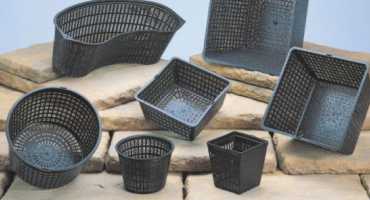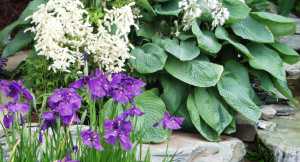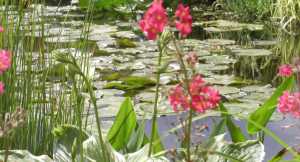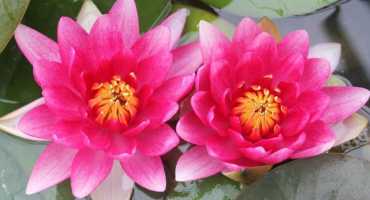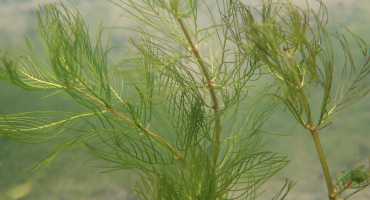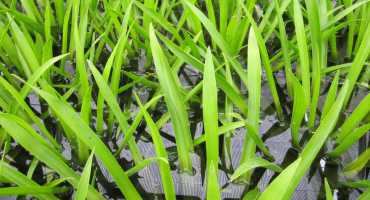Do I need pond plants?
It’s important that your pond or water feature has the right balance of aquatic plants to provide you with a year-round variety of colour and foliage as well as create a healthy and successful ecosystem in the water.
Not only do aquatic plants enhance the beauty of your pond, but they also play an important role in maintaining the balance of the pond and in keeping it clear. Plants absorb nutrients and reduce light levels in the water, which could otherwise promote the growth of algae, which causes green water. Plants will also provide shelter for fish and natural material on which they might spawn.
Choosing pond plants for your pond
Researching pond plants is no different to researching plants for your garden. All the water plants for ponds at World of Water are clearly labelled to show the height they attain, their spread and the depth of water they prefer. Mature pond plant specimens can also be seen in our show gardens and our staff team will happily answer any questions. To find out more about the pond plants for sale from your nearest World of Water Centre go to Pond Plants Near Me.
What size pond plants do I need?
The size of your pond matters when it comes to the types of plants you choose – vigorously growing pond plants are only suitable for larger ponds, while the slower growing aquatic plants are best suited to a smaller water feature.
Pond Plant Types
Bog plants – Perfect for around the edge of your pond, where the ground is damp but not waterlogged, and should be used to add interest to the pond’s border.
Marginal pond plants – Marginal pond plants should be placed in the outer shallows to bring colour and shape to the edges, especially during the summer months.
Lilies and deep water – The water lily is amongst the most stunning of all the water plants for ponds, lilies provide shade as well as texture to the deeper parts of your pond feature.
Oxygenators pond plants – Oxygenating pond plants are a key component to any pond, adding essential oxygen to the water during daylight hours. When searching, look out for oxygenating plants for fish ponds and oxygenating plants for small wildlife ponds.
Pond floating plants – Floating pond plants are low maintenance additions for your pond but create both shade and surface beauty to the water.
How many pond plants?
The key to success is incorporating aquatic plants into your pond is achieving a good balance of the different aquatic plant types. the table below is a rough guide to the number of immature pond plants you would need for your pond to ensure a stunning and healthy water environment.

Where to position pond plants?
Positioning your pond plants correctly is essential to kick start a vibrant and healthy water ecosystem. For example, some plants prefer to be in the depths of your pond, whilst others need to be kept on the surface. It is also important to take into account the potential height of a plant, as some grasses and rushes can grow very tall and eventually obscure a pond if poorly positioned.
How deep should pond plants be?
All plants will tolerate different depths of water which will be clearly labelled on the plant label or online in the desciption. The illustration below gives you a visual guide to the ideal planting area.
General Planting Depths - Variety Dependent (Check individual plant information)
- Bog Plants - Above Water Level
- Marginal - 15 cms deep to 0 cms
- Water Lilies & Deep Water
- Small Water lilies 30-60 cms deep
- Medium Water Lilies 30-90 cms deep
- Large Water lilies 30-150 cms deep
- Deep Water Plants 10-100 cms deep
- Oxygenating Plants
- Bunched - Anchor down up to 100 cms
- Planted - 15 cms deep to 0 cms
- Floating Plants - Water surface
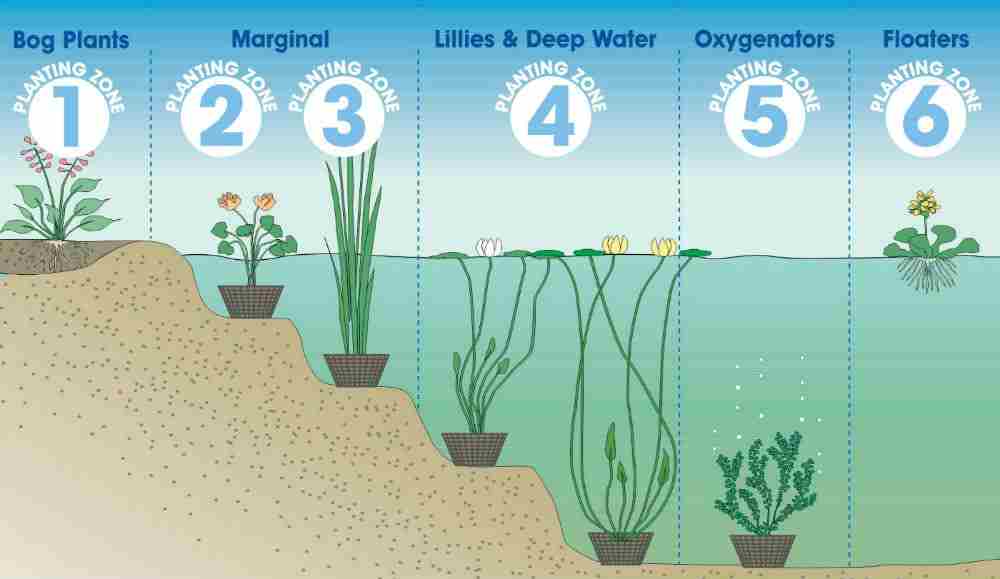
Choosing the right soil for pond plants
We suggest using a Aquatic compost specifically for pond plants. Ordinary bedding compost just won’t cut it and can potentially be fatal for your fish due to the high fertiliser content that’s designed for quick release.
Aquatic compost, has a slow release fertilizer benefiting the plants as they can absorb the nutrients as needed, reducing any nutrients leaching in to the pond water.
Aquatic compost is made using a heavy loam, as anything lighter such as a peat-based soil could just float away. For extra soil security under the water, use aquatic baskets, which are a mesh design to keep the soil in place. An added hessian liner in the basket works really well in preventing any soil leaching. Plus, the liner will rot over time, allowing the root structure of the plant to grow through the mesh and firmly knit the soil in place.
Pond Plant General care and maintenance
Once you have your chosen pond plants established, you will just need to keep on top of their maintenance as your stunning new pond gets into full bloom. Most ponds plants should be easy to keep in shape with regular trimming of excess foliage and removal of dead leaves and surface debris. With the right plants, the correct soil and sufficient light as well as nutrients, and you will have a fabulous natural water feature you can enjoy for many years to come.
Read out guide to pond plant pest and diseases
 British Pounds
British Pounds

